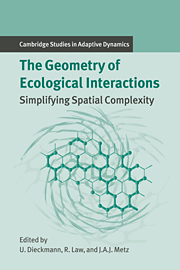Book contents
- Frontmatter
- Contents
- Contributing Authors
- 1 Introduction
- Part A Empirical and Statistical Background: A Plant Ecological Perspective
- Part B When the Mean-field Approximation Breaks Down
- Introduction to Part B
- 6 Grid-based Models as Tools for Ecological Research
- 7 Coexistence of Replicators in Prebiotic Evolution
- 8 Games on Grids
- 9 The Interplay between Reaction and Diffusion
- 10 Spirals and Spots: Novel Evolutionary Phenomena through Spatial Self-structuring
- 11 The Role of Space in Reducing Predator–Prey Cycles
- Part C Simplifying Spatial Complexity: Examples
- Part D Simplifying Spatial Complexity: Techniques
- References
- Index
- International Institute for Applied Systems Analysis
10 - Spirals and Spots: Novel Evolutionary Phenomena through Spatial Self-structuring
Published online by Cambridge University Press: 14 January 2010
- Frontmatter
- Contents
- Contributing Authors
- 1 Introduction
- Part A Empirical and Statistical Background: A Plant Ecological Perspective
- Part B When the Mean-field Approximation Breaks Down
- Introduction to Part B
- 6 Grid-based Models as Tools for Ecological Research
- 7 Coexistence of Replicators in Prebiotic Evolution
- 8 Games on Grids
- 9 The Interplay between Reaction and Diffusion
- 10 Spirals and Spots: Novel Evolutionary Phenomena through Spatial Self-structuring
- 11 The Role of Space in Reducing Predator–Prey Cycles
- Part C Simplifying Spatial Complexity: Examples
- Part D Simplifying Spatial Complexity: Techniques
- References
- Index
- International Institute for Applied Systems Analysis
Summary
Introduction
The concept of a hypercycle was introduced in the early 1970s (Eigen 1971) as a model for cyclic helping of self-replicating entities. Figure 10. 1a shows a schematic diagram of a hypercycle: each member of the cycle replicates itself and supports the replication of the next member. Eigen and Schuster (1979, 1982; Eigen 1992) suggested a role for hypercycles of ribonucleic acid molecules in prebiotic evolution. They showed that in prebiotic evolution there exists a so-called information threshold: the length of molecules is restricted by the accuracy of replication. In a hypercycle, each separate molecule species is constrained by the maximum string length, but the species can combine their information and thus cross the information threshold.
An important objection to the hypercycle theory has been raised by Maynard Smith (1979; see also Bresch et al. 1980): because there is no selection for the giving of catalytic support to the replication of another molecule, this property cannot be maintained. Giving catalytic support is an “altruistic” property; that is, it does not increase the number of copies of the molecule itself, but increases those of another, competing species.
As a result, a hypercycle is vulnerable to invasion by so-called parasites. Figure 10.1b shows a hypercycle with a parasite. The parasite is capable of self-replication on its own; in addition, it receives catalytic support from species 1 but does not give catalytic support to any other molecule.
- Type
- Chapter
- Information
- The Geometry of Ecological InteractionsSimplifying Spatial Complexity, pp. 171 - 182Publisher: Cambridge University PressPrint publication year: 2000
- 7
- Cited by



